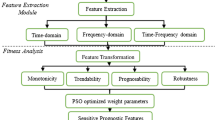Abstract
This study proposes a framework for bearing remaining useful life (RUL) prediction that uses multidomain features and a dual-attention mechanism (DAM). First, sparsity measures are introduced as new feature parameters to comprehensively and accurately extract the degradation features of bearings. Second, a long short-term memory network integrated with DAM is applied for RUL prediction. DAM simultaneously applies the attention mechanism to the time steps and feature dimension to increase the attention to important information and enhance the prediction performance of the network. Third, a pseudo-normalization method is proposed to solve the problem of unknown bearing test data in actual working conditions under the premise of retaining the original data characteristics and RUL prediction accuracy as much as possible. Lastly, the proposed framework is experimentally proven on public datasets and compared with other methods to prove its feasibility and effectiveness.
Similar content being viewed by others
Abbreviations
- x i :
-
Signal series
- N :
-
Number of time points
- f :
-
Frequency
- P(f):
-
Amplitude
- f(t 1):
-
Feature vector
- t k :
-
Time sequence
References
A. Heng, S. Zhang and A. C. C. Tan, Rotating machinery prognostics: State of the art, challenges and opportunities, Mechanical Systems and Signal Processing, 23 (3) (2009) 724–739.
R. S. Gunerkar, A. K. Jalan and S. U. Belgamwar, Fault diagnosis of rolling element bearing based on artificial neural network, Journal of Mechanical Science and Technology, 33 (2019) 505–511.
F. Wang, X. Liu and G. Deng, Remaining life prediction method for rolling bearing based on the long short-term memory network, Neural Processing Letters, 50 (3) (2019) 2437–2454.
S. Buchaiah and P. Shakya, Bearing fault diagnosis and prognosis using data fusion based feature extraction and feature selection, Measurement, 188 (2022) 110506.
L. Ren, J. Cui and Y. Sun, Multi-bearing remaining useful life collaborative prediction: A deep learning approach, Journal of Manufacturing Systems, 43 (2017) 248–256.
X. Jiang, Q. Song and H. Wang, Central frequency mode decomposition and its applications to the fault diagnosis of rotating machines, Mechanism and Machine Theory, 174 (2022) 104919.
Z. Zhang, J. Wang and S. Li, Fast nonlinear blind deconvolution for rotating machinery fault diagnosis, Mechanical Systems and Signal Processing, 187 (2023) 109918.
Y. Chen, G. Peng and Z. Zhu, A novel deep learning method based on attention mechanism for bearing remaining useful life prediction, Applied Soft Computing, 86 (2020) 105919.
J. Luo and X. Zhang, Convolutional neural network based on attention mechanism and Bi-LSTM for bearing remaining life prediction, Applied Intelligence, 52 (1) (2022) 1076–1091.
Y. Cao, Y. Ding and M. Jia, A novel temporal convolutional network with residual self-attention mechanism for remaining useful life prediction of rolling bearings, Reliability Engineering and System Safety, 215 (2021) 107813.
L. Guo, N. Li and F. Jia, A recurrent neural network based health indicator for remaining useful life prediction of bearings, Neurocomputing, 240 (2017) 98–109.
B. Han, Z. Yang and Z. Zhang, A novel rolling bearing fault diagnosis method based on generalized nonlinear spectral sparsity, Measurement, 198 (2022) 111131.
X. Jia, M. Zhao and Y. Di, Sparse filtering with the generalized lp/lq norm and its applications to the condition monitoring of rotating machinery, Mechanical Systems and Signal Processing, 102 (2018) 198–213.
Z. Zhang, L. I. Shunming and L. U. Jiantao, Intrinsic component filtering for fault diagnosis of rotating machinery, Chinese Journal of Aeronautics, 34 (1) (2021) 397–409.
Z. Zhang, S. Li and J. Lu, A novel intelligent fault diagnosis method based on fast intrinsic component filtering and pseudo-normalization, Mechanical Systems and Signal Processing, 145 (2020) 106923.
H. Zhang, Q. Zhang and S. Shao, Attention-based LSTM network for rotatory machine remaining useful life prediction, IEEE Access, 8 (2020) 132188–132199.
Y. Duan, H. Li and M. He, A BiGRU autoencoder remaining useful life prediction scheme with attention mechanism and skip connection, IEEE Sensors Journal, 21 (9) (2021) 10905–10914.
J. Yang, Y. Peng and J. Xie, Remaining useful life prediction method for bearings based on LSTM with uncertainty quantification, Sensors, 22 (12) (2022) 4549.
J. Zhu, Q. Jiang and Y. Shen, Application of recurrent neural network to mechanical fault diagnosis: A review, Journal of Mechanical Science and Technology, 36 (2) (2022) 527–542.
D. Wang, Spectral L2/L1 norm: A new perspective for spectral kurtosis for characterizing non-stationary signals, Mechanical Systems and Signal Processing, 104 (2018) 290–293.
L. He, C. Yi and D. Wang, Optimized minimum generalized Lp/Lq deconvolution for recovering repetitive impacts from a vibration mixture, Measurement, 168 (2021) 108329.
N. Li, Y. Lei and J. Lin, An improved exponential model for predicting remaining useful life of rolling element bearings, IEEE Transactions on Industrial Electronics, 62 (12) (2015) 7762–7773.
B. Wang, Y. Lei and N. Li, A hybrid prognostics approach for estimating remaining useful life of rolling element bearings, IEEE Transactions on Reliability, 69 (1) (2018) 401–412.
B. Zhang, L. Zhang and J. Xu, Degradation feature selection for remaining useful life prediction of rolling element bearings, Quality and Reliability Engineering International, 32 (2) (2016) 547–554.
P. Nectoux, R. Gouriveau and K. Medjaher, Pronostia: An experimental platform for bearings accelerated degradation tests, IEEE International Conference on Prognostics and Health Management, Denver, USA (2012).
Acknowledgments
This research was supported by the National Natural Science Foundation of China (52105110 and 52005303) and the Natural Science Foundation of Shandong Province (ZR2021QE024, ZR2020QE157, and ZR2022ME119).
Author information
Authors and Affiliations
Corresponding author
Additional information
Zongzhen Zhang received his Ph.D. degree from Nanjing University of Aeronautics and Astronautics, China, in 2020. He is currently an Associate Professor at Shandong University of Science and Technology. He is mainly engaged in research on mechanical dynamics and fault diagnosis.
Rights and permissions
About this article
Cite this article
Bao, H., Song, L., Zhang, Z. et al. Prediction of the remaining useful life of rolling bearings by LSTM based on multidomain characteristics and a dual-attention mechanism. J Mech Sci Technol 37, 4583–4596 (2023). https://doi.org/10.1007/s12206-023-0814-x
Received:
Revised:
Accepted:
Published:
Issue Date:
DOI: https://doi.org/10.1007/s12206-023-0814-x



